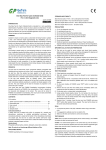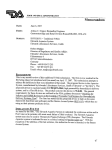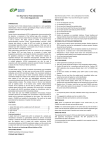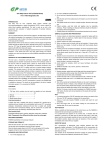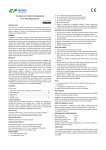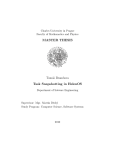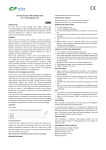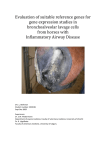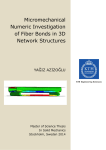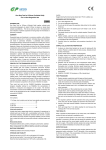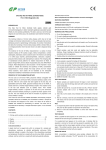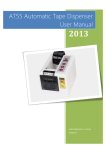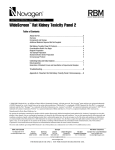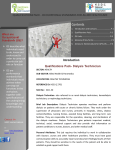Download See More - AD MEDICUM DOO
Transcript
Note: Components from different batches cannot be exchanged. One Step Test for β2-MG (Colloidal Gold) For In Vitro Diagnostic Use MATCHING EQUIPMENT FIA8000 Quantitative Immunoassay Analyzer Manual INTENDED USE One Step Test for β2-MG (Colloidal Gold) applies colloidal gold immunochromatography to detect beta2-microglobulin (β2-MG) in serum, plasma or whole blood samples quantitatively. Measurement of β2-MG is useful for the detection and evaluation of glomerular fitration rate, renal transplantation and renal function. SUMMARY β2-MG is an 11.8-kD protein, which forms one of the chains of the major histocompatibility complex (MHC) class I molecule normally present on the surface of every nucleated cell in the human body. Ninety percent of β2-MG is eliminated via glomerular filtration and almost completely reabsorbed by the proximal tubules. β2-MG is present in small amounts in serum, csf, and urine of normal people, and to a much greater degree in the urine and plasma of patients with tubular proteinemia, renal failure, or kidney transplants. Among the uremic toxins in the "middle molecule" range, β2-MG is certainly one of the most frequently studied compounds. Its serum level increases with the progression of chronic kidney disease, to reach very high concentrations in patients with end-stage kidney disease. It is the major protein component of dialysis-related amyloidosis, a dramatic complication which results from high extracellular concentration and posttranslational modification of β2-MG and a number of other promoters of amyloid fibril formation and deposition in osteo-articular tissues. Effective removal of β2-MG can be achieved with highly effective hemodialysis and hemodiafiltration techniques but predialysis session serum levels cannot be normalized. The prevalence and severity of β2-MG amyloidosis appear to have decreased in the last 20 years, although its occurrence may simply be delayed. PRINCIPLE OF THE EXAMINATION METHOD The test uses an anti-human β2-MG monoclonal antibody conjugated with colloidal gold and another anti-human β2-MG monoclonal antibody coated on the test line. After the sample (serum, plasma or whole blood) is applied to the test strip, the gold-labelled anti-human β2-MG monoclonal antibody binds to the β2-MG in sample and forms a marked antigen-antibody complex. This complex moves to the test card detection zone by capillary action, then be captured on the test line by another anti-human β2-MG monoclonal antibody resulting in a purplish red streak appears on the test line. The color intensity of the test line increases in proportion to the amout of β2-MG in sample. When inserting test card into the FIA8000 Quantitative Immunoassay Analyzer (hereafter referred to as FIA8000), the concentration of β2-MG in sample will be measured and displayed on the screen. The values will be stored in FIA8000 and available for downloading on demand. The result can be transmitted to the laboratory or hospital information system, if it is connected to FIA8000. CONTENTS A kit contains: 1. Foil bag, which contains one test card and one desiccant ······ 25 2. Manual ······································································· 1 3. SD card ···································································· 1 4. Blood sample diluent ···················································· 25 A test card consists of: A plastic shell and a reagent strip which is composed of a sample pad, nitrocellulose membrane (a colloidal gold-labelled anti-human β2-MG monoclonal antibody is coated at the border of the nitrocellulose membrane and sample pad, the test line is coated with another anti-human β2-MG monoclonal antibody, and the control line is coated with rabbit anti-mouse IgG antibody), absorbent paper and liner. Blood sample diluent: Phosphate buffered saline, proteins, detergent, preservative, stabilizer. STORAGE AND STABILITY Store the test card at 4~30oC with a valid period of 24 months. Use the test card within 1 hour once the foil bag is opened. o Store the blood sample diluent at 0~30 C with a valid period of 24 months. o Suggest storing the blood sample diluent at 2~8 C for a better use. WARNINGS AND PRECAUTIONS 1. For In-Vitro diagnostic use. 2. For use by healthcare professionals. 3. Do not use the kit beyond the expiration date printed on the outside of the box. 4. Keep the test card in the sealed pouch until ready to use. Do not reuse the used cards. 5. One pipette tip should not be used for multiple samples. Discard it after single use. 6. Patient samples, used test cards and pipette tips may be potentially infectious. Proper handling and disposal methods should be followed in accordance with local regulations. 7. Carefully follow the instructions and procedures described in this manual. SAMPLE COLLECTION AND PREPARATION 1. A serum, plasma or whole blood sample can be used for testing with this product. Samples should be free of hemolysis. 2. Sodium citrate or EDTA needs to be used as anticoagulant. 3. If testing cannot be completed immediately, the serum and plasma sample should be stored up to 7 days at 2~8oC or stored at -20oC for 6 months (whole blood sample should be stored up to 3 days at 2~8oC) until it can be tested. 4. Samples must be recovered to room temperature before testing. Frozen samples are required to be completely thawed and mixed thoroughly prior to testing. Minimize repeat freeze-thaw cycles to less than 3 times for tested samples to acquire accurate data. 5. Avoid heating the samples, which can cause hemolysis and protein denaturation. 6. SAMPLE VOLUME: 10 μl serum, plasma or whole blood. TEST PROCEDURE 1. Restore samples, sealed test-card foil bags and blood sample diluent to room temperature before using. Open the foil bag, label cards with numbers and use the test cards immediately. 2. Confirm SD card lot No. in accord with test kit lot No.. Perform “QC SD” operation (Details refer to 8.3.1 of FIA8000 User’s Manual) when necessary. 3. Add 10 μl serum, plasma or whole blood sample to one tube of blood sample diluent, and mix gently and thoroughly. Drop 120 μl of sample mixture to the sample port on test card. 4. Wait for 3 minutes, insert the card immediately into FIA8000 and press "OK" button, the test card can be detected and the result will be printed automatically. Note: 1. It is required to perform “QC SD” operation when using a new batch of kits; Only one “QC SD” operation is required for the same batch. 2. Assure of card side towards FIA8000 is correct and insert the card completely. TEST RESULTS When a purplish-red band appears in the control area, use the FIA8000 to analyse the test card and get a quantitative result. If no purplish-red band appears in the control area, it indicates that the operation is incorrect or the test card has passed its expiration date. In this case, please read the manual again carefully and use a new test card to try again, if the problem persists, please stop using all products of the same batch immediately and contact with your supplier. EXPECTED VALUE β2-MG concentration range is determined using samples obtained from 345 apparently healthy individuals. The reference range of β2-MG is 0.8mg/L~3.0mg/L calculated by using normal distribution methods. PERFORMANCE CHARACTERISTICS Measuring Range: 0.5mg/L ~20.0mg/L Lower Detection Limit: ≤0.5mg/L Within-Run Precision: ≤10% Between-Run Precision: ≤15% Method Comparison: The assay was compared to HITACHI 7170A and the matching β2-MG test kits with 207 patient serum samples (157 positive samples, 50 negative samples). The correlation coefficient (r) is 0.988. LIMITATIONS OF THE PROCEDURE 1. The result of the test should be evaluated in the context of all the clinical and laboratory data available. In those instances where the laboratory results do not agree with the clinical evaluation, additional tests should be performed accordingly. 2. Some substances in blood samples as listed below may interfere with the test and cause erroneous results. The maximum allowance concentration of them is as follows: Interfering Substance Concentration (Max) Hemoglobin 5 g/L Triglyceride 10 g/L Bilirubin 0.2 g/L DESCRIPTION OF SYMBOLS USED The following are graphical symbols used in or found on One Step Test for β2-MG (Colloidal Gold) are the most common ones appearing on medical devices and their packaging. They are explained in more detail in the European Standard EN 980: 2008 and International Standard ISO 15223-1:2007. Key to symbols used Manufacturer Expiration Date Do not re-use Date of manufacture Consult instructions Batch code for use Temperature In vitro diagnostic limitation medical device Authorized Sufficient for European Community REFERENCES 1. Madsen MG, Nørregaard R, Palmfeldt J, et al. Urinary NGAL, cystatin C, β2-microglobulin, and osteopontin significance in hydronephrotic children. Pediatr Nephrol. 2012, 27(11): 2099-2106. 2. Drüeke TB. β2-microglobulin and amyloidosis. Nephrol Dial Transplant. 2000, 15 (Suppl 1):17-24. 3. Li ZM, Zhu YJ, Sun J, et al. Serum beta2-microglobin is a predictor of prognosis in patients with upper aerodigestive tract NK/T-cell lymphoma. Ann Hematol. 2012, 91(8):1265-1270. 4. EN ISO 18113-1:2009 In vitro diagnostic medical devices - Information supplied by the manufacturer (labelling) - Part 1: Terms, definitions and general requirements. 5. EN ISO 18113-2:2009 In vitro diagnostic medical devices - Information supplied by the manufacturer (labelling) - Part 2: In vitro diagnostic reagents for professional use (ISO 18113-2:2009). representative in the CE marking Thank you for purchasing One Step Test for β2-MG (Colloidal Gold). Please read this manual carefully before operating to ensure proper use. Version:140317



